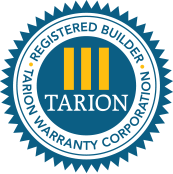The Construction Process
Here is a brief overview of the construction process at Tiffany Park:
The materials that will be used to build your new home will be ordered well in advance of the first day of construction, so it’s worth keeping in mind that any last minute changes can be expensive. This is why décor and interior finish selections must be made well ahead of time to prevent any complications when we’re ready to build. Completing your décor selection appointment on schedule is the most important thing you can do to ensure your house is constructed in a timely fashion.
The building process involves a number of stages, including:
- Excavation, laying the foundation and completing all underground servicing
- Complete framing, begin rough electrical, mechanical and plumbing, and install windows and doors
- Install partitions and drywall; complete electrical, mechanical and plumbing
- Install flooring and cabinetry; paint interior
- Final touches
- Home Occupancy!
Frequently Asked Questions
What does it mean if there is water on my window panes or window frames?
Usually this means there are high humidity levels in your home. This is not covered by warranty, but we recommend taking the appropriate steps to prevent condensation and/or dampness: remove or open heavy drapes/window coverings (Important: California shutters void warranty), and control humidity by dehumidification, ventilation or air conditioning. What does it mean if my insulated basement walls are leaking water or my cold room is wet?
What does it mean if my insulated basement walls are leaking water or my cold room is wet?
̬
This also usually means that you have high humidity levels in your home. This is not covered by warranty, but we recommend taking the appropriate steps to prevent condensation and/or dampness: control humidity by dehumidification, ventilation or air conditioning.
What does it mean if my basement and garage floors and walls have cracks?
̬
- Basement cracks are usually caused by a natural curing/shrinkage process and are aesthetic only, however if the crack is exceeding 4mm in width within the first year of closing it will be repaired under your warranty.
- Garage cracks are also usually caused by a natural curing/shrinkage process and are aesthetic only, however if the crack is exceeding 6mm in width within the first year of closing it will be repaired.
What should I do about roof leaks and visible water spots on 2nd floor ceilings only?
̬
- Snow/rain can possibly leak through attic vents from high winds, so it is best to check these first.
- Ice dams/icicles on roof must be removed by homeowners to prevent leaks. If it is determined that homeowners have failed to do this, any resulting leak damage will not be covered under warranty.
- Shingles missing, curled or cupped within the first year of closing will be repaired under warranty.
What about bathroom leaks and visible water spots on 1st floor ceilings only?
̬
- This is frequently caused by condensation/dampness on pipes & toilets from humidity. Homeowners must control bathroom humidity by always running exhaust fans when using water in bathrooms. Dehumidification, ventilation or air conditioning can also be used to control humidity. There is no warranty coverage for humidity related leakage and water spots.
- Faucets/plumbing fixtures that are found dripping/leaking within the first year will be repaired. If faucets/plumbing fixtures are dripping/leaking, the homeowner should take preventative measures against further damage by turning the shut off control valve to the Off position.
- Homeowners must follow proper winter maintenance procedures and ensure the shut off valves are Off when the home is left unheated, or homes must be kept at a proper temperature to ensure proper functioning of exterior pipes and pipes in basement, which will prevent freezing, bursts and leaks in the winter.
What about shower/bathtub leaks with visible water spots on 1st floor ceilings only?
̬
This kind of water damage can be prevented by installing shower curtains and/or doors, and through regular inspection and maintenance by homeowners to ensure seals and caulking have not deteriorated.
What do I need to do to maintain an ideal Interior climate/temperature?
̬
- Homeowners must change furnace filters regularly to ensure optimal furnace performance.
- Homeowners should not place any items over floor registers or against wall returns/vents, as this prevents proper air circulation.
- Rooms over garages, porches, foyers or north facing rooms are often affected by heat loss and tend to be generally cooler. Homeowners may wish to consider purchasing additional space heaters for these areas.
Preparing to Move
Follow these tips to ensure that every thing goes smoothly on moving day.
- Make sure to book a moving company well in advance of your move. We advise that you contact a reputable company a minimum of two months prior to your move-in date.
- Contact your lawyer to confirm the time and date when your keys can be picked up.
- For convenience, you may want to set up new bank accounts in the closest bank branch.
- Call your insurance company to arrange coverage for your new home.
- Moving day can be stressful enough without having to look after children or pets. It’s wise to arrange daycare or pet sitting services for moving day.
- Make an inventory list of all your belongings before packing, in case you need to make an insurance claim later. Take photos or video of valuables and record the serial numbers to all of your electronics.
- Make sure to use up all perishable food items in advance of your move so that there will be less to pack.
- Remember to register your children for their new schools and daycare.
- Take some time to locate nearby hospitals, police stations, fire stations and other important area amenities.
- Make sure to learn all the street parking bylaws in your new neighbourhood.
- Call the utility companies (water, hydro and gas) approximately two weeks before your closing date to set up service for your new home. You can arrange cable and telephone hook-ups after closing.
- Go to your local post office to fill out a change of address card, and then make sure to let all your friends and family know about your new mailing address. It’s also important to tell any companies you may deal with about the address change (e.g. bank, credit cards, cell phone company, etc.).
- Remember to notify all magazine and newspaper subscriptions about your change of address.
- Change the address on your driver’s licence and vehicle registration.
Preparing to Move
- Never trust important documents, jewellery, medication, etc. to the movers, always transport these kinds of items yourself.
- Pack medicines in a leak proof container.
- Remember to pack moving day essentials in one box to ensure that everything you need is easily accessible. This includes tools, paper products, all-purpose household cleaners, garbage bags etc.
- Make sure the boxes you use are strong and secure. It may be worth purchasing special boxes to transport breakables such as dishes.
- If possible, pack televisions and other audio/visual equipment in their original boxes. Label all cables, and tape all screws and other hardware to the piece of equipment they belong to.
- To ensure that everything is easy to transport, avoid packing boxes to more than 50 pounds in weight.
- Make sure each box is labelled with the following information: which room it’s to go in; whether or not it’s fragile; whether it should be loaded last so it can be unloaded first.
- Make sure to wrap fragile items in some way. You can save on the expense of bubble wrap by using old newspaper or towels and blankets.
- When packing books, you may notice that some have a musty smell. Sprinkle talcum powder between the pages and wrap the book before packing, then leave stored for a couple months to eliminate the smell.
- Have rugs and drapes cleaned before moving, them keep them wrapped for the move.

